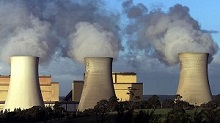Start stopping now, is the short answer. No new coal mines, oil wells or gas fields, and start decommissioning existing ones now. “Managed decline” is the new imperative.
- A new study released by Oil Change International, in partnership with 14 organizations from around the world, scientifically grounds the growing movement to keep carbon in the ground by revealing the need to stop all new fossil fuel infrastructure and industry expansion. It focuses on the potential carbon emissions from developed reserves – where the wells are already drilled, the pits dug, and the pipelines, processing facilities, railways, and export terminals constructed.
In other words, if we eat all the food already in the fridge we’ll become grotesquely obese.
The report looks at the carbon budget left for two possible climate stabilisation scenarios. The first is a 66% chance of limiting warming to 2°C, the second a 50-50 chance of limiting it to 1.5°C. I think these are unacceptable odds, but we’ll stick with them.
The report details some of the differences between the impact of 2°C and 1.5°C. For example, wheat yields would be reduced by 15% at 2°C compared to 9% at 1.5°C in a best estimate; the reduction could be as bad as 42% at 2°C versus 25% at 1.5°C.
This table updates the 2011 IPCC carbon budgets to 2015 in order to account for emissions over the four intervening years:
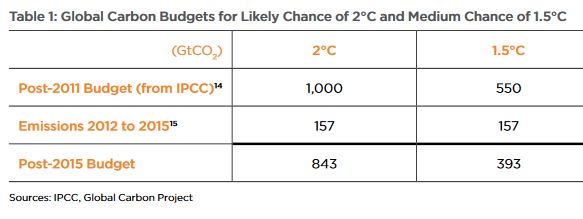
On that basis the way the budget is disappearing is quite startling.
This graph shows the emissions from existing fossil fuel reserves, plus land use and cement, against the carbon budgets:
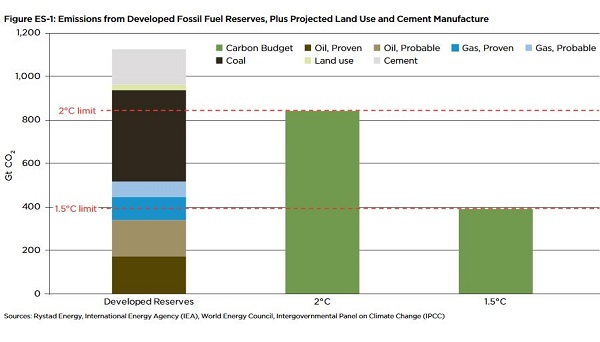
Bill McKibben in his article gives the 1.5°C scenario as 353 gigatons, because he was writing a year later than when the report was prepared, and the annual emissions are calculated at around 40Gt.
I suspect this is on the low side, as the Stern Report in 2006 found emissions to be around 43Gt pa, from memory. The genuine number, including such things as international transport and fugitive emissions, is probably in the low 50s.
The report recommends a “managed decline” of fossil fuels in favour of cranking up renewables to 50% by 2035 and 80% by 2045, using existing technology:
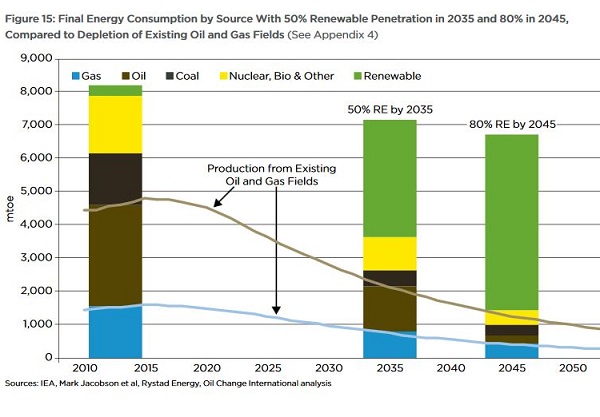
Mark Jacobsen and colleagues at Stanford University have developed detailed roadmaps for how 139 countries could achieve 80% renewable energy by 2030:
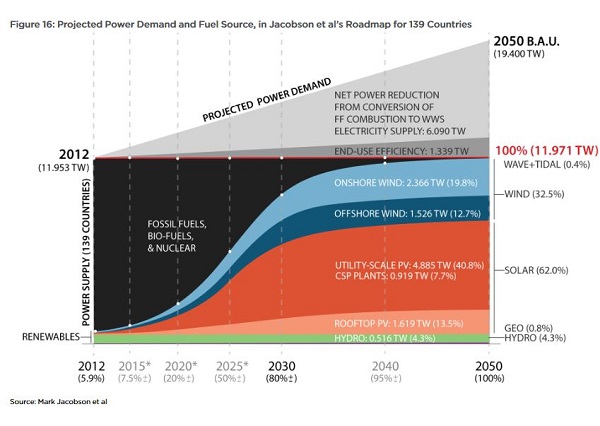
Neither of these groups have ignored issues of grid stability and storage. Both say these issues can be overcome using existing technology, based on international experience.
I have long suggested that we need to aim for zero emissions by 2030 and then take CO2 out of the atmosphere to 2050 to reach 350ppm as soon as possible.
Bill McKibben, writing in September, spells out the role of the US:
-
the existing mines and oil wells and gas fields contain 86 billion tons of carbon emissions—enough to take us 25 percent of the way to a 1.5 degree rise in global temperature. But if the U.S. energy industry gets its way and develops all the oil wells and fracking sites that are currently planned, that would add another 51 billion tons in carbon emissions. And if we let that happen, America would single-handedly blow almost 40 percent of the world’s carbon budget.
The Trump administration has the opportunity to do a lot of damage.
Some big unions,traditionally concentrating on saving existing jobs, are starting to realize that switching to renewable energy would add a million new good-paying jobs by 2030.
- Everyone from nurses to transport workers is opposing the Dakota pipeline; other unions have come out against coal exports and fracking. “This is virtually unprecedented,” says Sean Sweeney, a veteran labor and climate organizer. “The rise of ‘climate unionism’ offers a new direction for the labor movement.”
It’s the leaders of each level of government who need realise the priority that needs to be given.

